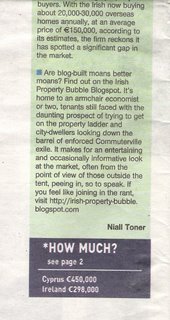News from the US on the continuing slowdown in the once frenetic housing market.
The
Boston Globe has this update. “After five red-hot years, home sales have cooled north of Boston and across the state. Gone are the days of multiple bids, price run-ups, and fast sales. Falling prices, rising inventory, and longer selling periods are now the norm, industry watchers say. ‘We’re at a turning point,’ said John Bitner, chief economist at Eastern Bank of Lynn. ‘The upward movement has definitely turned the other way. It’s a buyer’s market.’”
“Home sales in Massachusetts dropped 8.4 percent from January to March, compared with the same period last year, and 13 percent over the last 14 months, according to a report issued last week by the Warren Group. In March, home sales and prices dropped 1.5 percent, with the average selling price falling to $325,000 from $330,000 in March 2004.”
“The slowdown has left a glut of homes sitting idle, and hundreds of homeowners waiting impatiently for the chance to downsize, trade up, or move closer to family or even out of state for a job. Currently, 2,279 single-family homes are for sale north of Boston, a 48 percent increase over April 2005, when 1,538 homes were listed.”
“Eric and Denise Kerble of Swampscott put their spacious Colonial on the market in January for $399,900, betting it would sell fast in a seaside town where the average price tag on a single family house is at least $100,000 more. Now, after more than 100 days without an offer, the Kerbles have dropped their price to $394,900.”
“The couple paid $206,000 for the gray, 1,586-square-foot house eight years ago, outbidding several other prospective buyers. They said they have since spent more than $25,000 on upgrades.”
“‘We hope this does the trick,’ said Denise Kerble. ‘Lots of people have looked
at it, but nobody takes the next step.’
The Kerbles are one of the many Massachusetts families living in limbo, trapped in a suddenly stagnant real estate market that has forced them to put their dreams on hold.”
“In Middleton, competition from new homes for sale on East Street prompted Patrick and Susan McIntire to drop the price on their Colonial that they first listed at $419,900 in November. The house is priced at $399,900, but still has received no offers.”
‘We don’t want to give our house away,’ said Susan McIntire, who hopes to find
a house with more land in New Hampshire. ‘We’ve put a lot of sweat into it. But
it’s also very frustrating trying to sell a house now. There are more places to
live than people looking to buy.’”
“Local realtors say the falling prices and longer marketing periods show the market has come back down to earth after years of skyrocketing sales. With inventories climbing, sellers no longer can name their asking price. ‘Things are much more realistic now,’ said Claire Dembowski, a broker in Swampscott, who is also the listing agent for the Kerbles’ house. ‘Sellers had the advantage for a long time, but now the cycle is going the other way.’”








